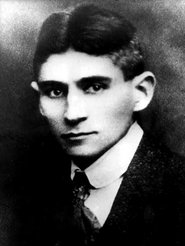
Atef Botros’s Kafka Study
A Jewish Writer from the Arab Perspective
Franz Kafka (1883-1924)
by Julian Tangermann, Qantara, June, 2010
Passionate literary criticism? Is this possible? As an academic discipline it is forbidden from emotion or passion. Nevertheless in Atef Botros’s Kafka, ein jüdischer Schriftsteller aus arabischer Sicht (Kafka, a Jewish writer, from the Arab perspective) this question is posed anew.
His well-founded, comprehensive critical analysis of Kafka’s reception in the Arab world closes with a passionate appeal for freedom in the Middle East. This does not, however, impair the academic rigour of the work in the slightest. In fact, his concerned, incisive view of the Middle East conflict and his excellent literary criticism feed off each other and make this work what it is.
The bulk of the book is concerned with the analysis of Kafka’s reception in the Arab world from 1939 to the present day; with how Kafka’s works have been understood and interpreted over the last seventy years in Arab countries and cultures. It posits three phases of responses to Kafka during this period, which are all examined according to their social, intellectual and literary implications.
Kafka in the Orient and Occident
The initial phase began with the interest in Kafka among Arabic-Francophone surrealist circles – their most famous representative being Georg Heinen, who wrote many articles in French on Kafka’s work – and with Taha Husein, who took it upon himself to make his intensive study of Kafka’s ideas accessible to the Arabic-speaking public.
Botros – who was born in Cairo, graduated from Leipzig University and is currently an academic at the Center for Near and Middle Eastern Studies at the Philipps University in Marburg, Germany – traces the flow of Kafka’s ideas into both authors’ intellectual projects. In Husein’s work, Kafka was important to his notion of a secular reading of Islamic scriptures. Heinen used him to support his arguments within the surrealist movement’s antifascist campaign and in the context of a secular avant garde in Egypt.
In the 1960s, following on from this first phase, an intensive period began in which Kafka’s works were translated into Arabic, bringing not only an increased interest among wider intellectual circles, but also more productive responses, with analyses of Kafkaesque subjects and motifs in contemporary Arabic works.
Botros illustrates this with several examples, explaining the cultural transferral these autonomous literary evaluations represent, and at the same time describing the significant role Kafka played in the process of renewal taking place in Arabic literature at this time.
Dominion of world politics
This brief period of wider popularity was succeeded by readings of Kafka in the context of political and politicised debates beginning in the 1970s and sparked off by the fact that Kafka’s Jewish identity and his Zionism. After a detailed discussion of this confrontation within the Arab world, with all its excessive polemics, Botros then goes on – in order to explain this – to decipher one by one the various Arab and European viewpoints on the phenomenon of Zionism.
Via a comparison between the differing appraisals of Kafka’s short story “Jackals and Arabs” he reveals the varying constructions of Zionism and the varying “lenses” through which the “Jewish” in Kafka’s work was perceived and judged; European observers necessarily saw Jewish history and Jewish-Arab confrontations in the light of the Holocaust, whereas Arab reflections on the issue – also necessarily – took the Israel-Palestine conflict and the Arab defeats as their starting point.
These “lenses” were used in the differing appraisals of Kafka’s work; he was seen either as a Zionist or anti-Zionist. At this point Botros proposes another way of assessing Kafka’s political position: we must develop a deeper understanding of the context a Jewish writer had to position himself in at the time in order to break through such black-and-white paradigms.
New perspectives on the Middle East conflict
On an abstract level this even means a new viewpoint on the Middle East conflict. Botros calls for a critical assessment, for the continued analysis of the “lenses”, which each influence the view of the other, in order to gain a better understanding of this complex conflict. Thus, impressively, Botros opens up an intellectual approach to the Middle East conflict via reactions to Kafka.
And it is precisely this multidimensionality of the work which enables the author to end his in-depth analysis of the Arab reception of the Jewish writer Kafka with an emotional appeal and request that “all sides of the conflict might finally realise, with regret, […] that it is based on misunderstanding and it is destroying us”.
The book is aimed at both specialist audiences and the interested general public, and its strength is its clear elucidation of the complex reactions to Kafka. Because his examinations are embedded in a comprehensive analysis of the twentieth century history of Arab humanities the book is easily understandable without extensive previous knowledge. The extensive bibliography on Kafka’s reception in the Arab world, on the other hand, opens the way for further academic study of the subject – a result of Botros’s exhaustive evaluation of source texts.
The book cannot therefore be characterised with one single word; it is an in-depth, complex analysis of trans-cultural processes of reception, and a profound work of literary criticism based on precise historical research – as well as a passionate, accessible appeal finally to view the Middle East conflict in a new way. Whichever aspect you wish to emphasise or to draw on, it remains a rewarding read.
© Qantara.de 2010
Translated from the German by Steph Morris